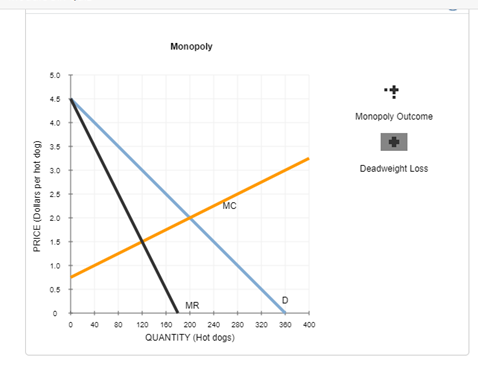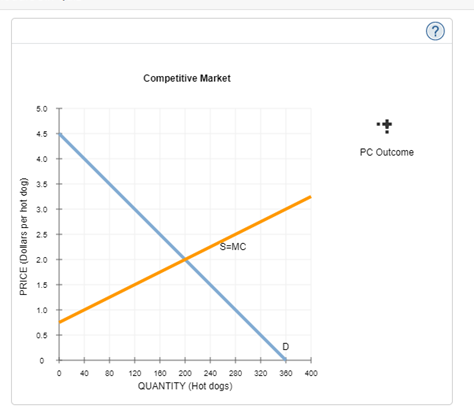Consider the daily market for hot dogs in a small city. Suppose that this market is in long-run competitive equilibrium with many hot dog stands in the city, each one selling the same kind of hot dogs. Therefore, each vendor is a price taker and possesses no market power. The following graph shows the demand (D) and supply (S = MC) curves in the market for hot dogs. Place the black point (plus symbol) on the graph to indicate the market price and quantity that will result from competition. Assume that one of the hot dog vendors successfully lobbies the city council to obtain the exclusive right to sell hot dogs within the city limits. This firm buys up all the rest of the hot dog vendors in the city and operates as a monopoly. Assume that this change doesn't affect demand and that the new monopoly's marginal cost curve corresponds exactly to the supply curve on the previous graph. Under this assumption, the following graph shows the demand (D), marginal revenue (MR), and marginal cost (MC) curves for the monopoly firm. Place the black point (plus symbol) on the following graph to indicate the profit-maximizing price and quantity of a monopolist. Consider the welfare effects when the industry operates under a competitive market versus a monopoly. On the monopoly graph, use the black points (plus symbol) to shade the area that represents the loss of welfare, or deadweight loss, caused by a monopoly. That is, show the area that was formerly part of total surplus and now does not accrue to anybody. Deadweight loss occurs when a monopoly controls a market because the resulting equilibrium is different from the competitive outcome, which is efficient. In the following table, enter the price and quantity that would arise in a competitive market; then enter the profit-maximizing price and quantity that would be chosen if a monopolist controlled this market. Market Structure Price Quantity (Dollars) (Hot dogs) Competitive Monopoly Given the summary table of the two different market structures, you can infer that, in general, the price is higher under a (COMPETETIVE MARKET OR MONOPLY) , and the quantity is higher under a (COMPETETIVE MARKET OR MONOPLY)
Consider the daily market for hot dogs in a small city. Suppose that this market is in long-run competitive equilibrium with many hot dog stands in the city, each one selling the same kind of hot dogs. Therefore, each vendor is a price taker and possesses no market power. The following graph shows the demand (D) and supply (S = MC) curves in the market for hot dogs. Place the black point (plus symbol) on the graph to indicate the market price and quantity that will result from competition. Assume that one of the hot dog vendors successfully lobbies the city council to obtain the exclusive right to sell hot dogs within the city limits. This firm buys up all the rest of the hot dog vendors in the city and operates as a monopoly. Assume that this change doesn't affect demand and that the new monopoly's marginal cost curve corresponds exactly to the supply curve on the previous graph. Under this assumption, the following graph shows the demand (D), marginal revenue (MR), and marginal cost (MC) curves for the monopoly firm. Place the black point (plus symbol) on the following graph to indicate the profit-maximizing price and quantity of a monopolist. Consider the welfare effects when the industry operates under a competitive market versus a monopoly. On the monopoly graph, use the black points (plus symbol) to shade the area that represents the loss of welfare, or deadweight loss, caused by a monopoly. That is, show the area that was formerly part of total surplus and now does not accrue to anybody. Deadweight loss occurs when a monopoly controls a market because the resulting equilibrium is different from the competitive outcome, which is efficient. In the following table, enter the price and quantity that would arise in a competitive market; then enter the profit-maximizing price and quantity that would be chosen if a monopolist controlled this market. Market Structure Price Quantity (Dollars) (Hot dogs) Competitive Monopoly Given the summary table of the two different market structures, you can infer that, in general, the price is higher under a (COMPETETIVE MARKET OR MONOPLY) , and the quantity is higher under a (COMPETETIVE MARKET OR MONOPLY)
Managerial Economics: A Problem Solving Approach
5th Edition
ISBN:9781337106665
Author:Luke M. Froeb, Brian T. McCann, Michael R. Ward, Mike Shor
Publisher:Luke M. Froeb, Brian T. McCann, Michael R. Ward, Mike Shor
Chapter6: Simple Pricing
Section: Chapter Questions
Problem 9MC
Related questions
Question
Consider the daily market for hot dogs in a small city. Suppose that this market is in long-run competitive equilibrium with many hot dog stands in the city, each one selling the same kind of hot dogs. Therefore, each vendor is a price taker and possesses no market power.
The following graph shows the demand (D) and supply (S = MC) curves in the market for hot dogs.
Place the black point (plus symbol) on the graph to indicate the market price and quantity that will result from competition.
Assume that one of the hot dog vendors successfully lobbies the city council to obtain the exclusive right to sell hot dogs within the city limits. This firm buys up all the rest of the hot dog vendors in the city and operates as a monopoly . Assume that this change doesn't affect demand and that the new monopoly's marginal cost curve corresponds exactly to the supply curve on the previous graph. Under this assumption, the following graph shows the demand (D), marginal revenue (MR), and marginal cost (MC) curves for the monopoly firm.
Place the black point (plus symbol) on the following graph to indicate the profit-maximizing price and quantity of a monopolist.
Consider the welfare effects when the industry operates under a competitive market versus a monopoly.
On the monopoly graph, use the black points (plus symbol) to shade the area that represents the loss of welfare, or deadweight loss , caused by a monopoly. That is, show the area that was formerly part of total surplus and now does not accrue to anybody.
Deadweight loss occurs when a monopoly controls a market because the resulting equilibrium is different from the competitive outcome, which is efficient.
In the following table, enter the price and quantity that would arise in a competitive market; then enter the profit-maximizing price and quantity that would be chosen if a monopolist controlled this market.
|
Market Structure
|
Price
|
Quantity
|
|---|---|---|
|
(Dollars)
|
(Hot dogs)
|
|
| Competitive |
|
|
| Monopoly |
|
|
Given the summary table of the two different market structures, you can infer that, in general, the price is higher under a (COMPETETIVE MARKET OR MONOPLY) , and the quantity is higher under a (COMPETETIVE MARKET OR MONOPLY).

Transcribed Image Text:Monopoly
5.0
4.5
Monopoly Outcome
4.0
3.5
3.0
Deadweight Loss
2.5
MC
2.0
1.5
1.0
0.5
D
MR
0 40 80
120 100 200 240 280 320 300 400
QUANTITY (Hot dogs)
PRICE (Dollars per hot dog)

Transcribed Image Text:Competitive Market
5.0
4.5
PC Outcome
4.0
3.5
3.0
2.5
S=MC
2.0
1.5
1.0
0.5
D
40
80
120 100 200 240 280
320 300 400
QUANTITY (Hot dogs)
PRICE (Dollars per hot dog)
Expert Solution
This question has been solved!
Explore an expertly crafted, step-by-step solution for a thorough understanding of key concepts.
This is a popular solution!
Trending now
This is a popular solution!
Step by step
Solved in 3 steps with 3 images

Knowledge Booster
Learn more about
Need a deep-dive on the concept behind this application? Look no further. Learn more about this topic, economics and related others by exploring similar questions and additional content below.Recommended textbooks for you

Managerial Economics: A Problem Solving Approach
Economics
ISBN:
9781337106665
Author:
Luke M. Froeb, Brian T. McCann, Michael R. Ward, Mike Shor
Publisher:
Cengage Learning

Managerial Economics: A Problem Solving Approach
Economics
ISBN:
9781337106665
Author:
Luke M. Froeb, Brian T. McCann, Michael R. Ward, Mike Shor
Publisher:
Cengage Learning